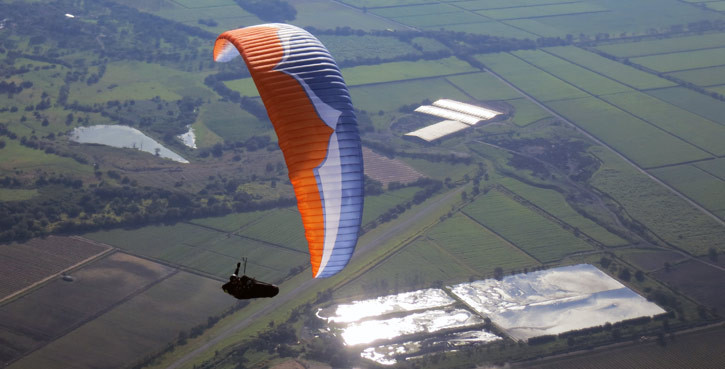Competition racers might think performance is the main priority, but for most pilots, wing handling is more important. You want to own a wing that makes you want to fly, and it's the feeling of the wing as you pass through the air that lingers with you, your connection with the shifting currents which you can never get enough of.
Ability
When the wing handling suits your ability, you get exactly the response you want, when you want it. Not too much forward pitching, but just enough that you can feel an approaching thermal and can cut through the gusts. Not too much rolling, but just enough that you can dig the wing into a thermal when it tries to push you out. Very little yaw, but just enough that you can whip the wing around in a quick turn when you hit lift suddenly.

'Just enough' relies on your reaction speed, which is unique to every pilot. This is determined by your currency, your experience, your training, your natural ability and your health. A wing that a friend might describe as 'docile' might become 'hot' in your hands if your active piloting responses are half a second behind his. But when you make the right match, you will outperform all the pilots who have overestimated their own abilities.
When I say the wing feels 'restrained' you probably understand that it won't throw you around and perhaps it won't turn as tightly as you want but there's room for misinterpretation: classifying handling is hardly scientific.
Reviews
I take great care when reviewing wings to use words that indicate how the average pilot in the class would experience the wing, not the way I feel about it personally, which is probably 'unresponsive, boring, low energy' for an EN B. I react fast so I can handle more movement from the wing and still be in a happy zone. When a wing lacks all the energy I'm used to, it frustrates my flying.
This is one reason why there can be disagreement among reviewers. Apart from the difference in skills, there's the difference in what the reviewer considers to be his 'ideal' pilot he is reviewing for. If the reviewer is only offering personal opinions, then the review is worth little to you: it's unlikely you will ever experience the wing that way.

Conditions
The flying conditions affect handling, in a big way. You can fly a wing on one day, and think it's really stable. On another day, the same wing can seem unnerving. As the wind increases, more turbulence is created throughout the airmass, especially near the surface or with any wind gradient. As you pass through these gusts, the airspeed of your wing changes temporarily, which changes its lift and drag characteristics, destroying an effective turn. It takes a lot of experience to be able to remove this noise from the real data. Reviews are often flavoured by the kind of conditions the reviewer is flying in.
In part 1 we showed how the wing class influences the handling. The sweet spot is the Sports class (broadly, mid EN C). Designers have the freedom to use more wing movement without the strict limits of the EN B test protocol. Turns are not hampered by the unwieldy wingspan of Performance Class wings. Pitch energy can be introduced to provide acceleration into turns, roll authority can be added for responsiveness. In a good Sports class wing like the Niviuk Artik 4, you get a balanced harmony, with just enough freedom in all three axes. You can really play in the sky.

Feedback
Feedback is the way the wing moves in disturbances and transmits this information to the pilot. I've flown Competition wings with low feedback and XC class wings with high feedback. In the Sports class, I like the design approach of the Ozone Delta 2, which has moderated feedback due to the set-back As. You probably won't notice the smaller shifts until you develop some sensitivity, at which point you are ready to tap into their potential. Until then, the wing seems calm.
Ground handling
Let's not forget ground handling. Avoid wings that drop back from 45 degrees or higher, are hard to bring back from the edge of the window using the brakes, accelerate and overshoot, don't fill quickly in zero wind forward launch or are hard to keep pinned on the ground in strong wind. This can mostly be guaranteed by staying in the XC class. However, none of the modern wings have such bad ground handling that you can't learn to master them after a few days of practice.
Brands
Although it's tempting to generalise the character of each brand, it's misleading because every wing is unique: Advance's Iota might be balanced, Niviuk's Artik 4 responsive and Nova's Mentor 4 steady, but their other designs might be quite different. Speak to pilots with experience on the wings you are considering.

Why handling matters
For a long time in your flying progression it will be your ability to thermal that will dictate your distance and not straight-line gliding performance. Without a wing with sensitivity to lift and responsive turning, you'll soon be just another pilot packing up in a field watching the others drift by. Find a wing with handling that supports your nature, and your performance will come as a result of your eagerness to find another thermal just for the feeling of digging your wing into it.
We hope this article and accompanying video (see below) help you gain more insight into paraglider handling.
Browse the range of wings we have to offer on our website.
How to Choose the Right Paraglider Part Four: Handling video
Brought to you by Flybubble
Like what we do? The best way to support us is to buy gear from us. Also recommend us and be a patron. Thank you!

